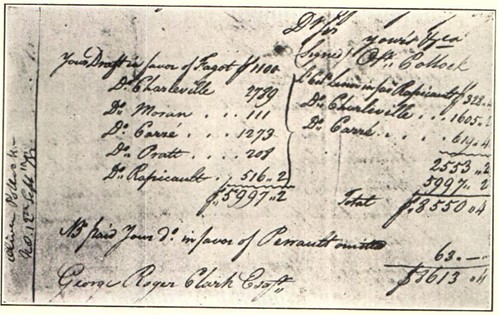
PREV ARTICLE
NEXT ARTICLE
FULL ISSUE
PREV FULL ISSUE
OLIVER POLLOCK AND THE U.S. DOLLAR SIGNDavid Sundman writes:
I have never seen mention of this Oliver Pollock invoice to Robert Morris origin theory mentioned in a numismatic work, have you? The reference to a specific year (1778) seems to indicate those Pollock invoices to Robert Morris exist somewhere? It would be nice to see one of the invoices.. This all seems to be consistent with your 2007 Cajori write-up." 
"Pollock reached into his own deep pockets and made available to the American war cause 300,000 Spanish pesos. That amount is valued at roughly one billion dollars in today's currency." "Pollock went broke. The expensive cost of raising of armies and supplies left him with nothing." "Oliver Pollock backed the right horse. It just didn't pay off." At right is a sculpture of Pollack in Baton Rouge. -Editor Washington's Superintendent of Finance, and Pollock's close friend and business partner, Robert Morris–himself a key financial backer of the Revolution–began the process by sifting through the countless ledgers sent to Congress by Pollock, who, per Dr. Cummins,"kept careful record of these amounts, noting both the Bills which he received and the supplies which he purchased." It was with those ledgers that Oliver Pollock finally achieved his dream of providing America with an important, lasting contribution. Not the numbers, but the poor penmanship that accompanied them. "Pollock...entered the abbreviation 'ps' by the figures for 'peso.' Because Pollock recorded these Spanish "dollars" or "pesos" as 'ps" and because he tended to run both letters together, the resulting symbol resembled a '$,'" says Jim Woodrick, the Historic Preservation Division Director of the Mississippi Department of Archives and History. That's it. Historians have analyzed the source of the $ symbol and have yet to find it written down prior to Pollock's use in his ledgers. His unintentional creation is supported by the fact that Robert Morris chose to adopt the symbol and by 1797 had it cast in type in Philadelphia as the official symbol for new nation's own currency. 
1778 letter from Pollock to George Roger Clark That narrower NNP search also turned up references on other numismatic works, including the article by Dr. Florian Cajori in the August 1929 issue of The Numismatist where a September 12, 1778 letter from Pollock to George Roger Clark is illustrated (not the earlier-mentioned ledger entry from the same year). Eric Newman was aware of this source when writing his 1995 ANS Coinage of the Americas Conference paper, "The Dollar $ign: Its Written and Printed Origins." Eric added material Cajori did not know about, and corrected things other people had written. Speaking of John Fitzpatrick and Oliver Pollock, his conclusion (on p20) is that they "... and many others had been sending and receiving trade documents and correspondence in great quantity using the $ sign in recognizable form, they must all be given credit for developing its practicality and its eventual general acceptance." I wouldn't bet against Eric Newman having the last word on the topic; as he notes in this case, new inventions often have multiple mothers and fathers; more than one origin story may have credence, and we may never definitively learn of any one single first occurence of the symbol. -Editor To read the Newman paper, see: For other Oliver Pollock references on the Newman Portal, here are my search results: To read earlier E-Sylum articles, see: To read the Atlas Obscura article, see: THE BOOK BAZARREWayne Homren, Editor The Numismatic Bibliomania Society is a non-profit organization promoting numismatic literature. See our web site at coinbooks.org. To submit items for publication in The E-Sylum, write to the Editor at this address: whomren@gmail.com To subscribe go to: https://my.binhost.com/lists/listinfo/esylum All Rights Reserved. NBS Home Page Contact the NBS webmaster 
|

